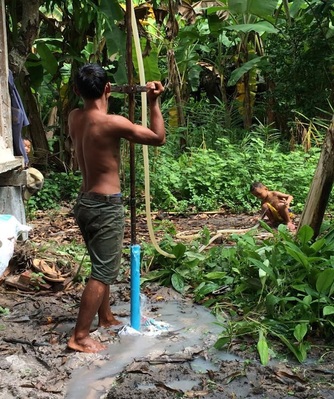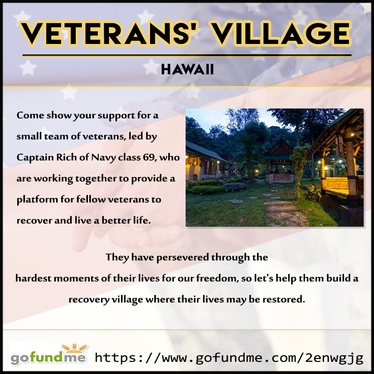Bringing Water to Those in Need
|
While living in Cambodia with his wife, Captain Rich installed three water wells for the people of the region. The process is a bit tedious and done by hand, but the results of such work offer those in need a new chance at living. Not only does it provide a better source of drinking water, but they’re also given a new way to irrigate crops to grow food in a much more efficient way than before.
If you’ve never been to Bathambong Province in the Cabrian District, you might be surprised to learn that the land there is very soft, with much of the farmland being rice paddy. This is what led Captain Rich to realize the potential of installing water wells in the area. From that realization, a notion of change was born.
The process, while convoluted to some, is actually rather straight forward. Using only a gas-powered water pump and hand power, a steel drill pipe is lowered into the ground. The end has a triangular spade welded to it, allowing the device to wash away sand, mud, and small rocks. This is the first step to clean, usable water, and it’s known as Hydraulicing.
If you’ve never been to Bathambong Province in the Cabrian District, you might be surprised to learn that the land there is very soft, with much of the farmland being rice paddy. This is what led Captain Rich to realize the potential of installing water wells in the area. From that realization, a notion of change was born.
The process, while convoluted to some, is actually rather straight forward. Using only a gas-powered water pump and hand power, a steel drill pipe is lowered into the ground. The end has a triangular spade welded to it, allowing the device to wash away sand, mud, and small rocks. This is the first step to clean, usable water, and it’s known as Hydraulicing.
|
After the initial hole is dug, the pipe is rotated repeatedly and pushed downward as water is pumped through it, circulating underground to wash out all extra debris. When the end of the first pipe is near the ground level, another is attached via treaded couplings and the process continues until the desired depth is attained.
Once drilling is complete, the water is shut off and extraction begins. After the pipe is pulled up and the joints are removed at each junction, a well-shaped hole is left behind. It is just as deep as needed, but slightly larger in circumference than the drill pipe used. Next, the well must be installed. It begins with the installation of a filter, which will keep any future debris from entering the system. This filter is made using a hacksaw to cut small, angled slits onto the ends of the plastic pipe that will be used to outline the well. Then, a small mesh sock is placed over the bottom end of the pipe and taped at the top so it can't slip off. This filtering method does a great job of keeping out sand and mud, which would otherwise contaminate the water. |
After the filter is installed, the next pipe is heated, softening it so the end can be spread open. Then, a smaller piece of pipe is placed over both to create a joint, connecting the filter pipe with the well’s main pipe. This process saves money as they don’t need to buy plastic fittings; they just create their own.
Once the joint is glued, the newly connected pipes are inserted into the ground. Like the process to dig the hole above, this step is repeated until the desired depth is reached. At that point, any extra pipe is cut down to a desired level. This is where the water pump will be attached.
Once the joint is glued, the newly connected pipes are inserted into the ground. Like the process to dig the hole above, this step is repeated until the desired depth is reached. At that point, any extra pipe is cut down to a desired level. This is where the water pump will be attached.
|
Like earlier, the pipe must be heated to enlarge its opening, allowing the water pump and pipe to be connected. Unlike earlier, however, no glue is used here. Instead, they cut tire tubes into long, two-inch wide bands that are wrapped around this joint. This is done several times so that there is an area of pipe about one foot long that's covered by the rubber wraps as a seal. Along with the protection of this seal, a wood post is hammered into the ground for extra stability of the pump.
At this point, the well is almost finished. The next step is testing the pump. Before they begin, clean water is poured into the pump to prime it. As the pump goes into action, murky, clouded water will first emerge from the well for what seems like an extended period of time. While the process continues over the next few days, however, the water will slowly become clear and clean. |
The results of this process can vary depending on the area and the contaminants in the ground, but the water gained from these wells will improve conditions ten-fold. Not only is it much cleaner than the water they are used to drinking, but the people in these areas will now have easy access to water for their everyday needs.
|
Along with utilizing this new water source for drinking and daily uses, it will be used by these hardworking people to hand irrigate their crops. One well can be shared by friends and family, completely changing many lives in a tremendous way.
Their appreciation for help and lack of selfishness is what fuels the desire to keep pitching in. It’s rather ironic that small, simple acts of compassion can lead to such big surprises. It was the influence of theses cultures and the bamboo village lifestyle that motivated Captain Rich to start the Veterans Village Hawaii project as an opportunity to bring the same type of closeness to our homeless and PTSD veterans. The aim is to create a similar environment, where stigmas and labels such as homelessness/PTSD/bi-polar/ADHD and such, have no bite. |




